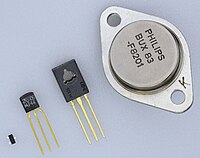
Photo from wikipedia
In the present work we reveal the existence of the hot carrier photovoltage induced across a p–n junction in addition to the classical carrier generation-induced and thermalization-caused photovoltages. On the… Click to show full abstract
In the present work we reveal the existence of the hot carrier photovoltage induced across a p–n junction in addition to the classical carrier generation-induced and thermalization-caused photovoltages. On the basis of the solution of the differential equation of the first-order linear time-invariant system, we propose a model enabling to disclose the pure value of each photovoltage component. The hot carrier photovoltage is fast since it is determined by the free carrier energy relaxation time (which is of the order of 10−12 s), while the thermal one, being conditioned by the junction temperature change, is relatively slow; and both of them have a sign opposite to that of the electron-hole pair generation-induced component. Simultaneous coexistence of the components is evidenced experimentally in GaAs p–n junction exposed to pulsed 1.06 μm laser light. The work is remarkable in two ways: first, it shows that creation of conditions unfavorable for the rise of hot carrier photovoltage might improve the efficiency of a single junction solar cell, and second, it should inspire the photovoltaic society to revise the Shockley–Queisser limit by taking into account the damaging impact of the hot carrier photovoltage.
Journal Title: Applied Sciences
Year Published: 2020
Link to full text (if available)
Share on Social Media: Sign Up to like & get
recommendations!